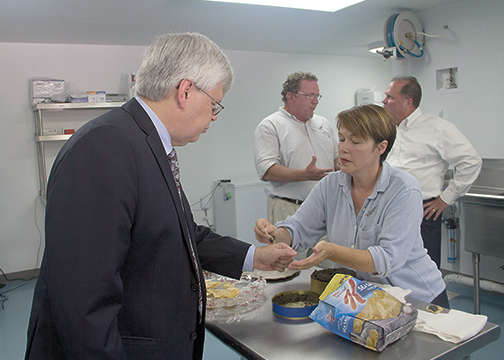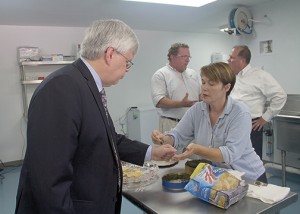

Editor
Not many villages can say they have a caviar farm in their village, but New Richmond can.
Renee Koerner founded Big Fish Farms with her husband, Keith, because she wanted to create a product.
Koerner was originally thinking of making bourbon, but met a professor who mentioned caviar. Once Koerner got to try making caviar for herself, she loved it and decided that was what she wanted to do.
That was about 10 years ago. Koerner has been in the market for about four years, but this is the first year Koerner is taking her own fish to market.
Koerner uses paddlefish indigenous to the area. When she has newly hatched fish, she lets them grow at her farm in a pool for a year.
In the fall, Koerner moves them to one of the local places she partners with and lets them grow in a lake for eight to 10 years. The fish will only reproduce in rivers, not in a lake, Koerner said, so there is no danger of a population boom in these lakes.
When she removes them from the lake, she typically gets about 80 percent of the fish she put in about a decade prior. Putting the fish in a lake allows them natural food and the space to exercise, Koerner said.
“I call it free range caviar,” she said.
She does not just put the fish in lakes, however. Newport Aquarium and Shedd Aquarium in Chicago both have some of her fish in tanks.
Timing is critical for removing the fish. If Koerner does not get to the females soon enough, they will absorb the eggs.
“You don’t want to sacrifice an animal you’ve got so much time in,” Koerner said.
She used to get the fish in February or March, but found that the lake would be frozen or the banks would be too soft to get vehicles to the lake. This year, Koerner is going to move the fish to the lake on her property in December to avoid those issues.
Koerner’s pond has diffusers so it won’t freeze.
If Koerner is harvesting 100 fish, she would probably take 10 trips to get them. The fish get smart and get used to the nets, so they won’t swim into them. Koerner spreads her trips over four or five weeks.
She is anticipating 100 females this year and next year.
She uses the male fish for meat. As the fish are boneless, Koerner said the texture of the fish is like a tender meat, similar to veal.
Koerner began as an urban farmer, but moved to New Richmond so she could build a place to process fish. She has a small building in her yard that she works in.
When Koerner built her processing building, she was able to personalize it and decide what she liked and didn’t like, she said.
She is picky about things like the salt she uses on the caviar, Koerner said.
“I feel like I was able to set the bar really high as far as quality,” Koerner said.
She sells a kilo of fish for $600-800.
Her caviar can be found at Orchids at Palm Court and at Jean-Robert’s Table, both in Cincinnati.
